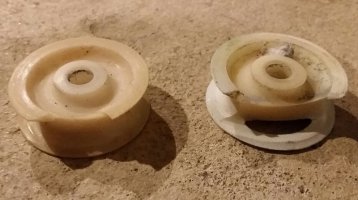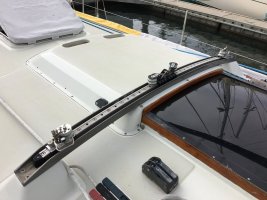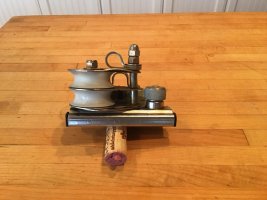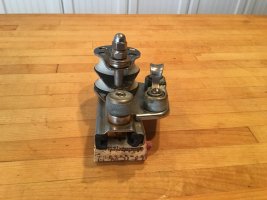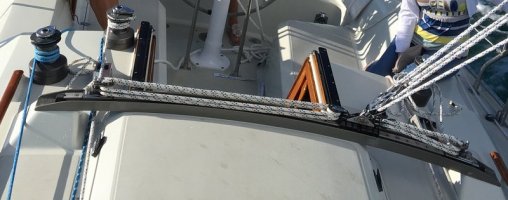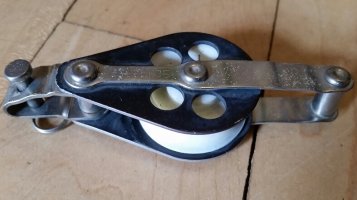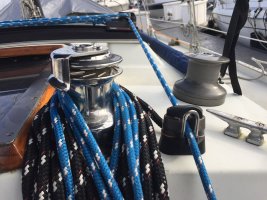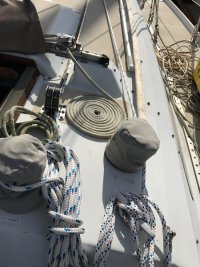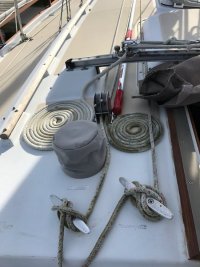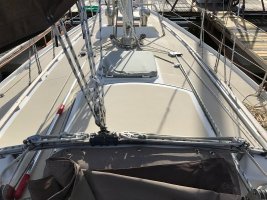supersailor
Contributing Partner
I'm down in Portland for xmas and after the third attempt at posting this message, I realize how much I hate this HP Pavillion.  I may leave off the pix or shorten the message. The program says it auto saves but I don't see a way to retrieve the message. I will try posting the pix then do the narrative this time as the pix seems to be the problem.
I may leave off the pix or shorten the message. The program says it auto saves but I don't see a way to retrieve the message. I will try posting the pix then do the narrative this time as the pix seems to be the problem.

All my lines lead aft including all of both ends of the reef lines and my jib furler is on the cabin top. All of the foresail functions are on the port side of the cabin top including the spinnaker halyard, the pole lift and guy, the jib halyard and the jib furler. The starboard side includes the Main halyard, main sheet, Cunningham, and two reefs.
The cabin top winches are two speeds so they crank in both directions. Helpful for the outer two when the dodger is on. The halyards and sheet are concentrated on the inner two winches as is the jib furler. One can stand on the companionway ladder while cranking but I usually just kneel when the dodger is on. I have the strongtrack system so I can muscle up the main until the last 3' or so. It runs down all by itself.
Late last November, I took a solo cruise to the San Juan Islands. Leaving Friday Harbor, the wind was blowing 12 Knots. By the time I reached the turn point, the wind was 22 knots and the jib was partially furreled and the main had a reef in it. 20 minutes later, the wind was a steady 35. The main disappeared. Over the top of San Juan Island, Terra Nova was doing 9 1/2 knots in a nasty tide and wind induced chop. Most thrilling! By the time I reached Roche Harbor, the wind was a steady 38 with higher gusts. I was sure glad I could do all of this from the cockpit. Solo docking at Roche was sure exciting but that's a different story!
All my lines lead aft including all of both ends of the reef lines and my jib furler is on the cabin top. All of the foresail functions are on the port side of the cabin top including the spinnaker halyard, the pole lift and guy, the jib halyard and the jib furler. The starboard side includes the Main halyard, main sheet, Cunningham, and two reefs.
The cabin top winches are two speeds so they crank in both directions. Helpful for the outer two when the dodger is on. The halyards and sheet are concentrated on the inner two winches as is the jib furler. One can stand on the companionway ladder while cranking but I usually just kneel when the dodger is on. I have the strongtrack system so I can muscle up the main until the last 3' or so. It runs down all by itself.
Late last November, I took a solo cruise to the San Juan Islands. Leaving Friday Harbor, the wind was blowing 12 Knots. By the time I reached the turn point, the wind was 22 knots and the jib was partially furreled and the main had a reef in it. 20 minutes later, the wind was a steady 35. The main disappeared. Over the top of San Juan Island, Terra Nova was doing 9 1/2 knots in a nasty tide and wind induced chop. Most thrilling! By the time I reached Roche Harbor, the wind was a steady 38 with higher gusts. I was sure glad I could do all of this from the cockpit. Solo docking at Roche was sure exciting but that's a different story!


